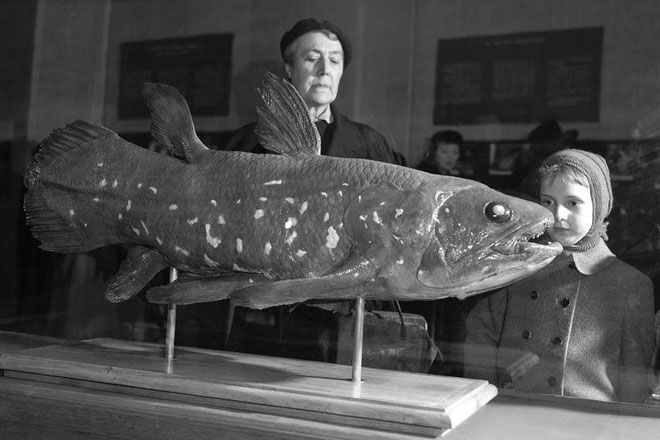'Living fossil' fish is pregnant for 5 years
Ancient 'slow-living' fish Coelacanth with lifespan of up to a century and gestation period of five years, new study finds.
Coelacanths , a species of fish that has existed since the time of dinosaurs, mature at a very slow rate, according to a study by French scientists published on June 17 in the journal Current Biology, AP reported on June 18.
According to research, female Coelacanths do not reach sexual maturity until their late 50s, while males reach reproductive age between 40 and 69 years of age.
Known as a 'living fossil ,' the Coelacanth fish has been around for 400 million years. It was thought to be extinct until it was discovered in 1938 off the coast of South Africa, a discovery that shocked the scientific community at the time.
It is said that the reason fishermen "accidentally" discovered this animal is because they were using special Gillnet nets , which aim to catch more sharks.
This upgraded net incorporates advanced technology, allowing access to very deep water areas, at depths ranging from about 328 to 492 feet (equivalent to about 150 meters) below the sea surface. Notably, this is also the preferred habitat of the Coelacanth fish.
Coelacanth is so endangered that scientists can only study dead specimens.

The Coelacanth fish was thought to be extinct for a long time but was unexpectedly discovered in 1938. (Photo: AP).
In the past, scientists estimated the age of fish by counting the large lines on a piece of Coelacanth's scale . Using this method, the lifespan of Coelacanth fish was previously estimated to be around 20 years.
However, French scientists found that this method missed smaller lines that can only be seen using polarized light - the commercial technique for determining fish age.
Bruno Ernande, a study co-author at the French Institute of Marine Research, said that polarized light revealed that each large band was accompanied by five smaller bands. The researchers then concluded that each band corresponded to one year of age for the coelacanth, which put the oldest specimen they had at 84 years old.
Using the same technique, scientists continued to study two embryos of Coelacanth fish, from which they estimated that the largest specimen was 5 years old. Therefore, they determined that the gestation period of Coelacanth fish lasts at least 5 years . Coelacanth fish reproduce directly like humans, without laying eggs.
The five-year gestation period is 'very unusual' for a fish or other animal, said Harold Walker of the Scripps Institution of Oceanography in the US. Walker was not part of the research team.
Although genetically unrelated and evolutionary different, Coelacanths have a slow maturation rate similar to deep-sea fish (like sharks and rays), according to Ernande.
'They may have similar evolutionary histories because their habitats are similar ,' said Mr Ernande.
Coelacanths have a very unique body structure. They are the only known living animals to have joints in their skulls, which clearly divide the front and back of the skull from the inside.
Scientists explain that the bending at the joints may help the "coelacanth" open its mouth wide and swallow large prey.

Coelacanth fish have a very different body structure. (Photo: Reuters).
Coelacanth fish have sharp eyes with a "tapetum lucidum" structure (a reflective substance similar to that in cats' eyes), which helps them adapt and avoid being hunted in all natural conditions, including at night.
Coelacanths live in deep water and are about the size of an adult human, move slowly and are known as "living fossils". They are nocturnal and grow very slowly.
- Surprising creature that can 'interbreed across 100 million years of evolution'
- The discovery of 200 million year old fossil fish in China
- Why were more than 200 fish 'sealed' at the same time in a fossil from 50 million years ago?
- 'Living fossil' fish haven't evolved in 100 million years
- Fossil turtle pregnant
- Pregnant women eat a lot of fatty fish prone to premature birth
- 200 million year long sea fossil remains intact
- The father is pregnant and then kills the child
- Discovering fossil fish fossils 152 million years
- Biological fossil discovery 545 million years ago
- Marine fish species appear in Vietnamese sea
- Excavating fish fossils 429 million years old
 Animal 'suffering' after hibernation
Animal 'suffering' after hibernation Why do goats climb well?
Why do goats climb well? Scientists were surprised to see chimpanzees eating turtles
Scientists were surprised to see chimpanzees eating turtles Giant catfish died deadly due to drought in Thailand
Giant catfish died deadly due to drought in Thailand